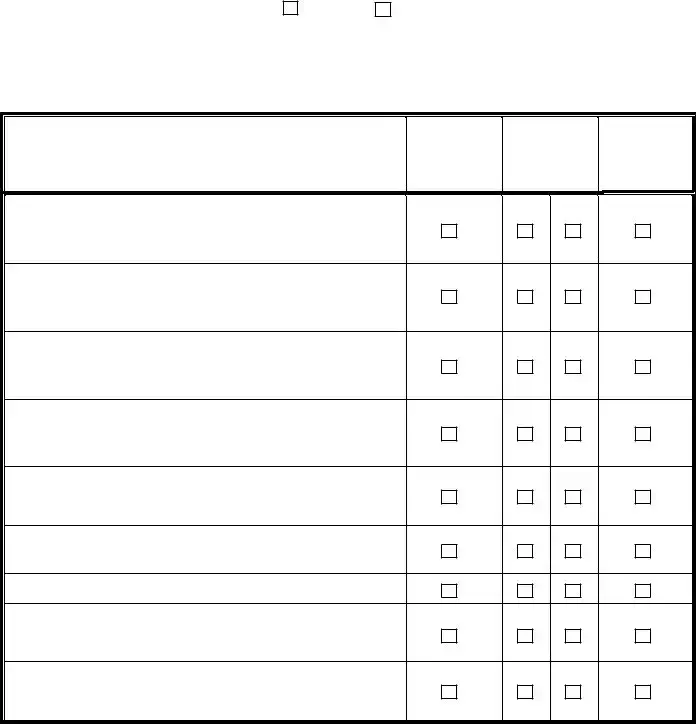STAFF PERFORMANCE APPRAISAL FORM
NAME: _________________________________________________ EMPLOYEE ID NO: __________________________
DEPARTMENT: ___________________________________ CLASSIFICATION TITLE: ___________________________
TYPE OF APPRAISAL: |
ANNIVERSARY |
APPRAISAL PERIOD: FROM: __________________________ TO: ____________________________
This form must be returned to the Division of Human Resources by ________________. If the form is not received by this
date, rating will automatically default to Achieves Performance Standards.
INSTRUCTIONS: This appraisal form must be completed by the immediate supervisor based on performance standards previously established. If the selected category is “Achieves Standards” the supervisor must indicate the level of rating: M=Marginal or P= Proficient. If the overall is Achieves Standards Marginal or Below Standards, the supervisor must contact the Employee and Labor Relations Department for assistance in implementing a Performance Improvement Plan.
EXCEEDS ACHIEVES BELOW STANDARDS STANDARDS STANDARDS
P  M
M
JOB KNOWLEDGE:
QUALITY OF WORK:
PRODUCTIVITY:
DEPENDABILITY:
ATTENDANCE:
RELATIONS WITH OTHERS:
COMMITMENT TO SAFETY:
SUPERVISORY ABILITY: (applicable only to designated supervisor positions)
OVERALL APPRAISAL RATING: (one CATEGORY must BE CHECKED)
Distribution: |
Original – Human Resources |
Copy – Supervisor |
Copy - Employee |

RATING FACTORS
THE FOLLOWING ARE CONDITIONS THAT SHOULD BE CONSIDERED WHEN ASSESING THE EMPLOYEE’S PERFORMANCE:
JOB KNOWLEDGE: In depth knowledge of all requirements of the job. How well does the employee understand all phases of the job as defined by the performance standards set for the position?
QUALITY OF WORK: Accuracy and neatness. Does the employee produce a high quality work product? Is quality work a priority for the employee?
PRODUCTIVITY: Consider employee’s ability to prioritize and organize work effectively to meet assigned deadlines. Were assignments timely completed and appropriate follow-up implemented? Is the employee a self starter?
DEPENDABILITY: Employee needs little or no direction. To what extent can the employee be relied upon to carry out instructions; and the degree to which the employee can work with limited supervision?
ATTENDANCE: Attendance and punctuality are very important in maintaining a normal work load and efficient schedule. Employees are expected to report to work regularly and be ready to perform their assigned duties at the beginning of their assigned work shift. Is the employee absent frequently? Are the absences affecting his/her performance? Does this pattern constitute a hardship on the work environment?
RELATIONS WITH OTHERS: Consider employee’s abilities to maintain a positive and harmonious attitude in the work environment. How well does the employee relate to the supervisors, co-workers and the broader University community.
COMMITMENT TO SAFETY: To what extent has the employee adhered to the recommended safe work practices, participated in safety training programs; and contributes to the recognition and control of hazard in his/her work area.
SUPERVISOR ABILITY: In the evaluation of this factor, consider the employee’s ability to organize, plan, train, delegate and control the work of subordinates in an effective manner.
LEVELS OF PERFORMANCE
THE EMPLOYEE’ S PERFORMANCE SHALL BE RATED IN ONE OF THE FOLLOWING CATEGORIES:
EXCEED PERFORMANCE STANDARDS: An evaluation resulting from overall performance which is significantly above the performance standards of the position.
ACHIEVES PERFORMANCE STANDARDS – PROFICIENT: An evaluation resulting from performance which fully meets the performance standards of the position.
ACHIEVES PERFORMANCE STANDARDS – MARGINAL: An evaluation resulting from performance which barely meets the performance standards of the position. The supervisor must contact the Division of Human Resources to initiate a Performance Improvement Plan, which must be completed jointly by the employee and the supervisor.
BELOW PERFORMANCE STANDARDS: An evaluation resulting from performance which fails to meet the minimum performance standards of the position. The supervisor must contact the Division of Human Resources to initiate a Performance Improvement Plan, which must be completed jointly by the employee and the supervisor.
Distribution: |
Original – Human Resources |
Copy – Supervisor |
Copy - Employee |
Page Two
PERFORMANCE APPPRAISAL FORM
RATER’S OVERALL COMMENTS:
SECOND LEVEL SUPERVISOR’S COMMENTS: (Optional)
EMPLOYEE’S COMMENTS (Use attachments, if necessary):
EMPLOYEE’S SIGNATURE: _____________________________________________ DATE: _____________________
Signature does not imply concurrence with rater’s appraisal, only that appraisal was administered.
PLEASE PRINT
RATER’S NAME: _______________________________________________________
RATER’S SIGNATURE: __________________________________________________ DATE: _____________________
PLEASE PRINT
SECOND-LEVEL SUPERVISOR’S NAME: ______________________________________________________________
SECOND-LEVEL SUPERVISOR’S SIGNATURE: ____________________________ DATE: _____________________
EMPLOYEE’S REFUSAL TO SIGN: I certify that this performance appraisal was discussed with the employee who refused to sign it.
RATER’S CERTIFICATION: ______________________________________________ DATE: ____________________
*Please deliver form to the Division of Human Resources, Payroll Department, PC 220.
Distribution: |
Original – Human Resources |
Copy – Supervisor |
Copy - Employee |
Revised 10/15/2007


 M
M
